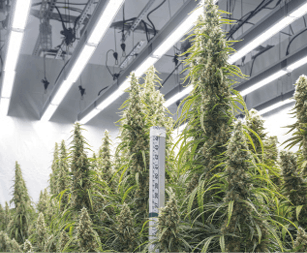
1. How can cultivators produce more consistent plants?
Consistency comes down to three pillars of plant development—yield, morphology and chemical consistency. Chemical consistency is the most challenging but also the most crucial for many cannabis growers. People don’t necessarily want to consume plants with the highest THC concentrations, for example. Some may want a product with a more diverse terpene profile instead.
If growers want to achieve specific production objectives, there are ways of getting there by manipulating and utilizing different aspects of the environment. Understanding the pillars and overall cultivation goals will impact how a grower builds their entire environment, but particularly how they determine their lighting strategy.
2. How can growers optimize their lighting strategy to yield more consistent plants or even specific chemical profiles?
Optimizing metabolic pathways with light is critically important to cannabinoid profiles (or potency). Plant chemical profiles are complicated, and by manipulating light quality, we can explore how to drive entire metabolic pathways one direction or another to optimize overall chemical profiles.
Cannabinoids and terpenes are chemically similar. The cannabinoids and terpenes relevant to recreational and medical markets share a common precursor, which is geranyl pyrophosphate or GPP. With GPP, you can make monoterpenes, producing other elements like linalool, beta-pinene, etc. Ultimately, there are many intermediate steps between the initial GPP precursor and synthesizing various terpenes and cannabinoids. Evidence suggests that we can adjust the plant’s preference for driving these different pathways by using different light qualities.

3. Can you share an example of how you’ve changed the lighting environment to draw out a specific, highly desired cannabinoid or terpene?
We’ve performed a study where we manipulated the red to far red light ratio—far red is just a slightly longer wavelength than red light—and observed the ratios of alpha-pinene, beta-pinene and linalool shift. If you give the plant more far red, it’s like the plant sees a stop sign for that biochemical pathway. When it starts to make alpha- and beta-pinene, it doesn’t make anything past that. If we go the other way, and we apply a little bit more red instead of far red, it will drive that synthesis to its end point a little bit more rapidly, so alpha- and beta-pinene might go down but linalool might go up.
4. Why is this important?
It is becoming increasingly clear for both cannabinoid and terpene consistency that shaping the environment by tailoring lighting solutions and light spectrum can achieve a very specific chemical profile. Cultivators will be able to grow a plant with a consistent experience or could even push the boundaries of a cultivar. At Fluence, we’re not going to tell people what the right chemical profile is. However, when conclusive findings come out that say, to treat epilepsy, for instance, you need a certain amount of linalool or myrcene, that’s when [cultivators] are going to come to us and say, “How do we do that?” As our understanding of the interaction between light quality and plant development continues to evolve, we are excited to answer that question and more through our groundbreaking research.
